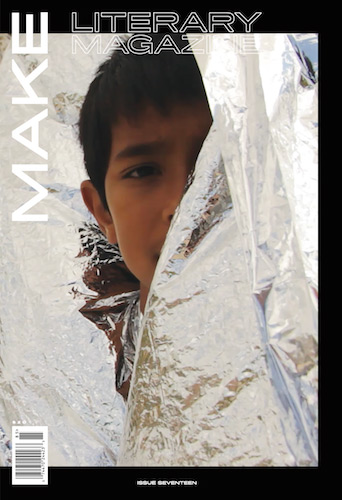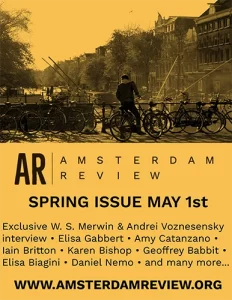MAKE – 2017-2018
MAKE, published annually out of Chicago, dedicates this issue to belonging. This theme is unsurprising given the journal hosts the annual Lit & Luz Festival of Language, Literature, and Art in Chicago and in Mexico City, encouraging cross-pollination of creativity across culture and language. Bringing together fiction, nonfiction, poetry, and translation, this issue of MAKE stretches belonging to encompass belonging in our bodies, belonging within (and to) a place, and belonging within language.
MAKE, published annually out of Chicago, dedicates this issue to belonging. This theme is unsurprising given the journal hosts the annual Lit & Luz Festival of Language, Literature, and Art in Chicago and in Mexico City, encouraging cross-pollination of creativity across culture and language. Bringing together fiction, nonfiction, poetry, and translation, this issue of MAKE stretches belonging to encompass belonging in our bodies, belonging within (and to) a place, and belonging within language.
In their essay “Notes to a Real Self,” Kelly Caldwell blurs the line between belonging within their body and belonging within language. While recuperating in a mental hospital, Caldwell confronts bodily belonging as non-binary. They directly relate physical belonging with linguistic belonging. “She [the therapist] calls me Kelly, the first person to do so aside from my partner. Language though, feels spoiled.” This deeply personal relationship between language and their body is given the same weight as Caldwell’s later, more academic understanding of language and queerness. Caldwell’s belonging is enmeshed in their body and equally enmeshed in parsing out language to uncover where they belong.
Margarita Garcia Robayo’s short story “It Could Be Worse” (translated from the Spanish by Sarah Booker) also focuses on belonging within one’s body. Titi is a young boy born with health problems that cause him to be morbidly obese. Rather than dwell on Titi’s ostracization from his peers, Robayo explores the body as monstrous and grotesque. Titi plays a videogame where he creates an avatar in his own image: “[h]is feet were webbed; his hands clawed; and he had big tits, tongues that hung down to his knees.” It’s not enough that his mother loves and supports him in order for him to belong. Robayo raises questions about what it takes to belong within one’s family and in one’s body.
Continuing to examine belonging within family, Andrea Rehani’s essay “Yellow” examines her Assyrian identity as a woman born and raised in the United States. Her essay crosses belonging in body, place and language and she situates us in this liminal space by mixing the senses in her imagery. “My culture smells like a lemon peel, which feels suffocating.” Rehani further disorients us through her use of similes in the midst of fragmented sentences. “Faded, scars; the scattered birthmarks. Like polka dots [ . . . ]. Like bruises.” She continues, “Being Assyrian feels yellow. [ . . . ] Like Christmas lights.” Despite knowing English, Arabic, and Suraye, she still does not have the language to say exactly what she experiences. It is like something familiar and yet it is not that thing at all. She navigates belonging within her body, within place, and within myriad languages.
Irma Pineda also exposes us to belonging within language. Her six poems come from her collection of poetry, Doo yoo ne ga’ bia’ / De la casa del ombligo a las nueve cuartas – From the Cord House to the Nine Handspans. The pieces are translated from the Spanish by Wendy Call, but each poem is printed three times: Call’s English translation, Pineda’s Spanish, and Pineda’s Zapotec—a language native to Mexico. Pineda raises the point that to belong within language can also be a means of exclusion: and this exclusion is alright. In her poem “Alleyways,” she begins each stanza with the specificity of place: “My town has.” But she writes the last section in Zapotec with no translation. Even with an editorial note to provide context for Pineda’s work, the Zapotec unseats readers; we are not expected to know the language. But within this unsettling nature of not understanding, it becomes clearer what we do understand: the emotion of the piece presented and a greater appreciation of context. Most importantly, we appreciate what it feels like to not belong.
Yet, for a journal that crosses definitions of belonging, the index over-categorizes. This wouldn’t be an issue, except the layout of the magazine at times makes the pieces’ titles unreadable due to a massive font size. In contrast, you have to search for the author’s name on the page. I referenced the index with each piece and wondered about the specificity of classification. Wouldn’t certain pieces classified under Reviews and Critical Essays be better served under a broader label of nonfiction? And what does Interviews and Ephemera cover, when there is only one interview? Most importantly, why is there such an editorial distinction at all?
Despite the strangeness in organization, MAKE’s theme runs strong, expanding and probing the massive topic of belonging. In the end, we can more easily see ourselves and those who are not us—in any or every way—equally deserving of belonging and the complexities that entails.
[www.makemag.com]





